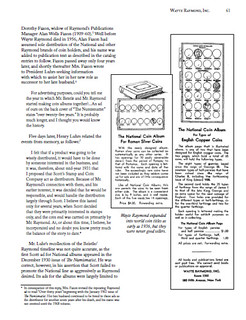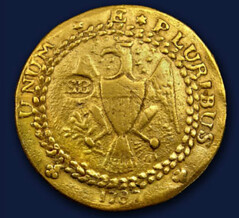
PREV ARTICLE
NEXT ARTICLE
FULL ISSUE
PREV FULL ISSUE
NOTES FROM E-SYLUM READERS: SEPTEMBER 29, 2013 Dollar Piece or Peace Dollar? In the notice of Baldwin's sale of the Arielle collection, shown is a Sierra Leone 1791 proof dollar with the legend "ONE DOLLAR PIECE" and the clasped hands symbol for 'peace.' I wonder whether 'piece' was meant to be spelled as it is? No, I haven't made any effort to find out. Yes, lazy...

Well, that's a good question. I hadn't thought of it as any more than a declaration of the coin's value, a "One Dollar Piece". But the clasped hands could symbolize a peace accord. Is the wording intentional? Was it meant only to represent the denomination, or as a pun?
-Editor
To read the earlier E-Sylum article, see: BALDWIN'S ARIELLE COLLECTION OF BRITISH COLONIAL COINS (www.coinbooks.org/esylum_v16n39a23.html) National Coin Album Roman Coin Pages
Even more rare are the National pages for English copper coins by type from James I through George V. These were offered only in the large or portrait format pages, Lange Numbers RNLE1 and RNLE2 (the Publisher Numbers are unknown). I was not able to find even a single example of either of these pages, so they too must have been flops for Wayte Raymond. They were offered concurrently with the Roman pages, and I'm attaching a page from my book which shows the ads for both. To read the earlier E-Sylum article, see: QUERY: NATIONAL COIN ALBUM ROMAN COIN PAGES SOUGHT (www.coinbooks.org/esylum_v16n39a10.html) Fort McHenry and Fire Museum of Maryland Exhibits Jane and I arrived there at about 10:30 but our purpose was to see an exhibit which includes over 30 pieces from our collection. As a second thought I purchased two rolls of quarters. The current exhibit at Fort McHenry focuses on anniversary celebrations of the Star Spangled Banner in 1889, 1914 and 1964. The room where it is located is just past the ranger station on the left. Most people likely assume that they cannot or should not enter the room. Next year the focus will be more on the actual Battle of Baltimore in 1814. At this time, we also have two different exhibits at the Fire Museum of Maryland. One has to do with the Fire Department in the early 1870's and 1880's. The other features the Battle of Baltimore and related items including document signed by Admiral Cochrane, Admiral Cockburn, Major General Ross, all British leaders of the attack. Other documents are signed by Major General Samuel Smith, military leader of the defense, Major George Armistead, commander at Fort McHenry and James McHenry (they named a fort after him), and other pieces. To read the earlier E-Sylum article, see: FORT MCHENRY QUARTER LAUNCH CEREMONY REPORT (www.coinbooks.org/esylum_v16n39a13.html) Smithsonian Exhibit Suggestions Coins to include in the Smithsonian exhibit: the first and last U.S. $20 gold pieces...not for circulation...1849 and 1933. Eric Schena writes:
The coins have storied pedigrees that spans the history of coin collecting in the US, plus have even bridged the gap into popular culture, to include the movies (The Brasher Doubloon, 1947) and it does not get much more American than Hollywood. In addition, it can be used to discuss trade in the 1780s and 1790s, as well as the value of the coin itself as an objet d'art. That would be an excellent way to broach multiple subjects in one object and not restrict it to just numismatic arcana. To read the earlier E-Sylum article, see: QUERY: INPUT FOR NEW SMITHSONIAN NUMISMATIC EXHIBIT SOUGHT (www.coinbooks.org/esylum_v16n39a11.html)
Great ideas! But I could have sworn we'd get a flood of suggestions for must-have artifacts to display in the next permanent exhibit of the Smithsonian's National Numismatic Collection. But that's all we've heard this week. Any other suggestions, readers?
-Editor

Wayne Homren, Editor The Numismatic Bibliomania Society is a non-profit organization promoting numismatic literature. See our web site at coinbooks.org. To submit items for publication in The E-Sylum, write to the Editor at this address: whomren@gmail.com To subscribe go to: https://my.binhost.com/lists/listinfo/esylum All Rights Reserved. NBS Home Page Contact the NBS webmaster 
|

